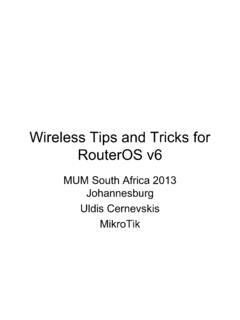Transcription of Load Balancing Using PCC & RouterOS - MikroTik
1 Load Balancing Using PCC & RouterOSAbout Me Steve Discher, from College Station, Texas, USA Class of 87 Texas A&M University Using MikroTik since early 2004 when I started my first WISP Author of the book RouterOS by Example MikroTik Certified Trainer and teach RouterOS classes, Operate a wireless distribution company, What is load Balancing and why would I want it?2. Which method should I pick and how does it work?3. Ok, I want it but how do I set it up?Typical Scenario Requiring Load BalancingProblem: No high capacity circuits available, DSL onlyDistribution: Fiber, Copper, Wireless, , Apartments, , Apartments, : Fiber, Copper, Wireless, Scenario Requiring Load BalancingSolution: Multiple low capacity circuits, RouterOS load balancing1. What is load Balancing and why would I want it?1. What is load Balancing and why would I want it? Process to utilize multiple internet connections in such a manner as to proportionately distribute internet traffic across all the connections.
2 1. What is load Balancing and why would I want it? Process to utilize multiple internet connections in such a manner as to proportionately distribute internet traffic across all the connections. Distribution may be symmetrical or asymmetrical depending on circuit What is load Balancing and why would I want it? Process to utilize multiple internet connections in such a manner as to proportionately distribute internet traffic across all the connections. Distribution may be symmetrical or asymmetrical depending on circuit availability. Useful when the downstream bandwidth requirement to a single routing device exceeds the capabilities of a single internet Balancing in GeneralOptions AvailableLoad Balancing in General First, the type of load Balancing we are discussing today should not be confused with any type of bonding protocol or sub-packet based load Balancing . Options AvailableLoad Balancing in General First, the type of load Balancing we are discussing today should not be confused with any type of bonding protocol or sub-packet based load Balancing .
3 Bonding, MLPP, etc. require that the protocol be recognized on both the subscriber and provider ends. Not available with commodity internet AvailableLoad Balancing in General First, the type of load Balancing we are discussing today should not be confused with any type of bonding protocol or sub-packet based load Balancing . Bonding, MLPP, etc. require that the protocol be recognized on both the subscriber and provider ends. Not available with commodity internet connections. Can t simply bridge two DSL or Cable modem connections, doesn t AvailableLoad Balancing in General First, the type of load Balancing we are discussing today should not be confused with any type of bonding protocol or sub-packet based load Balancing . Bonding, MLPP, etc. require that the protocol be recognized on both the subscriber and provider ends. Not available with commodity internet connections. Can t simply bridge two DSL or Cable modem connections, doesn t work. There are several methods to provide load Balancing in RouterOS .
4 Options AvailableExampleOptions AvailableLoad Balancing Options With RouterOS : ECMP - Equal Cost Multi-Path routing Options AvailableLoad Balancing Options With RouterOS : ECMP - Equal Cost Multi-Path routing Per-address pair load balancingOptions AvailableLoad Balancing Options With RouterOS : ECMP - Equal Cost Multi-Path routing Per-address pair load Balancing Doesn t work well for certain protocols, connections break when routing table flushes every ten minutes to prevent DOS attacksOptions AvailableLoad Balancing Options With RouterOS : ECMP - Equal Cost Multi-Path routing Per-address pair load Balancing Doesn t work well for certain protocols, connections break when routing table flushes every ten minutes to prevent DOS attacks Nth Load Balancing - Per connection load Balancing , with the addition of persistent connectionsOptions AvailableLoad Balancing Options With RouterOS : ECMP - Equal Cost Multi-Path routing Per-address pair load Balancing Doesn t work well for certain protocols, connections break when routing table flushes every ten minutes to prevent DOS attacks Nth Load Balancing - Per connection load Balancing , with the addition of persistent connections Hybrid / Custom Setups - Solutions based on one or more methods above with the addition of scripts or policy routing to make the solution more AvailableLoad Balancing Options With RouterOS : ECMP - Equal Cost Multi-Path routing Per-address pair load Balancing Doesn t work well for certain protocols, connections break when routing table flushes every ten minutes to prevent DOS attacks Nth Load Balancing - Per connection load Balancing , with the addition of persistent connections Hybrid / Custom Setups - Solutions based on one or more methods above with the addition of scripts or policy routing to make the solution more intelligent.
5 Bandwidth based load Balancing - MPLS, Traffic Engineering, AvailableLoad Balancing Options With RouterOS : ECMP - Equal Cost Multi-Path routing Per-address pair load Balancing Doesn t work well for certain protocols, connections break when routing table flushes every ten minutes to prevent DOS attacks Nth Load Balancing - Per connection load Balancing , with the addition of persistent connections Hybrid / Custom Setups - Solutions based on one or more methods above with the addition of scripts or policy routing to make the solution more intelligent. Bandwidth based load Balancing - MPLS, Traffic Engineering, etc. PCC - Per Connection ClassifierOptions AvailableLoad Balancing Options With RouterOS : ECMP - Equal Cost Multi-Path routing Per-address pair load Balancing Doesn t work well for certain protocols, connections break when routing table flushes every ten minutes to prevent DOS attacks Nth Load Balancing - Per connection load Balancing , with the addition of persistent connections Hybrid / Custom Setups - Solutions based on one or more methods above with the addition of scripts or policy routing to make the solution more intelligent.
6 Bandwidth based load Balancing - MPLS, Traffic Engineering, etc. PCC - Per Connection Classifier Simple, effective, scalable, no nasty side effectsOptions AvailableLoad Balancing Options With RouterOS : ECMP - Equal Cost Multi-Path routing Per-address pair load Balancing Doesn t work well for certain protocols, connections break when routing table flushes every ten minutes to prevent DOS attacks Nth Load Balancing - Per connection load Balancing , with the addition of persistent connections Hybrid / Custom Setups - Solutions based on one or more methods above with the addition of scripts or policy routing to make the solution more intelligent. Bandwidth based load Balancing - MPLS, Traffic Engineering, etc. PCC - Per Connection Classifier Simple, effective, scalable, no nasty side effects Per-address pair load Balancing methodOptions AvailableLoad Balancing Options With RouterOS :2. How does it work?2. How does it work? PCC divides the incoming data into streams and then uses routing rules to sort the traffic evenly (or not) across multiple WAN How does it work?
7 PCC divides the incoming data into streams and then uses routing rules to sort the traffic evenly (or not) across multiple WAN connections. This is done by:2. How does it work? PCC divides the incoming data into streams and then uses routing rules to sort the traffic evenly (or not) across multiple WAN connections. This is done by:1. Using a hashing algorithm to first sort the traffic based on source address, source port, destination address, destination port or various combinations How does it work? PCC divides the incoming data into streams and then uses routing rules to sort the traffic evenly (or not) across multiple WAN connections. This is done by:1. Using a hashing algorithm to first sort the traffic based on source address, source port, destination address, destination port or various combinations Using packet marking and routing marks and several routing tables to ensure traffic follows a specified route out the specified WAN How does it work?
8 PCC divides the incoming data into streams and then uses routing rules to sort the traffic evenly (or not) across multiple WAN connections. This is done by:1. Using a hashing algorithm to first sort the traffic based on source address, source port, destination address, destination port or various combinations Using packet marking and routing marks and several routing tables to ensure traffic follows a specified route out the specified WAN interface. Understand the SolutionUnderstand the Solution MikroTik RouterOS is extremely powerful and configurable, so this can be a double edged sword, several possible solutions to the same problemUnderstand the Solution MikroTik RouterOS is extremely powerful and configurable, so this can be a double edged sword, several possible solutions to the same problem Each has multiple moving piecesUnderstand the Solution MikroTik RouterOS is extremely powerful and configurable, so this can be a double edged sword, several possible solutions to the same problem Each has multiple moving pieces Greatest success with any solution by understanding the pieces and what they do.
9 Understanding the PCC Load Balancing the PCC Load Balancing Solution1. Packet - The container for our data, header and the PCC Load Balancing Solution1. Packet - The container for our data, header and Connections - Conduit through which host to host communication occurs, based on Src/Dst addresses and the PCC Load Balancing Solution1. Packet - The container for our data, header and Connections - Conduit through which host to host communication occurs, based on Src/Dst addresses and Facility - Firewall function within RouterOS that allows you to create a mark which is then associated with packets that can be identified later by other functions like firewall rules or routing the PCC Load Balancing SolutionUnderstanding the PCC Load Balancing Solution4. PCC - Per Connection Classifier, function contained with the Mangle Facility to sort traffic into streamsUnderstanding the PCC Load Balancing Solution4. PCC - Per Connection Classifier, function contained with the Mangle Facility to sort traffic into streams5.
10 routing Table - Route rules, the rules the router uses to determine what to do with a packet. By comparing the destination address in the packet to the list of routes, the router decides which interface to send the packet out. By adding a routing mark with mangle, we can have multiple routing tables!Understanding the PCC Load Balancing SolutionA packet is like a letter & envelope. The front is the header and the letter inside the envelope is the Address & PortDestination Address & Port 1. What is a packet?Understanding the PCC Load Balancing SolutionIPv4 HeaderSource Address (sender)Destination Address (receiver)PortPortProtocol2. What are connections?Understanding the PCC Load Balancing SolutionConnections are always in one of three states - new, established, or What is the mangle facility?Understanding the PCC Load Balancing SolutionIf - Then: Identify and then perform some What is PCC? Per Connection Classifier is a mangle option that sorts data into streams that can be marked for identification the PCC Load Balancing Solution(s)Unsorted InSortingSorted StreamsWhere is it found?



















